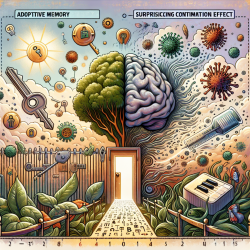Introduction
In the realm of speech-language pathology, understanding how memory works is crucial for developing effective therapeutic strategies. Recent research titled The Mnemonic Tuning for Contamination: A Replication and Extension Study Using More Ecologically Valid Stimuli has uncovered fascinating insights into how our memory can be enhanced by certain cues. This blog explores these findings and their implications for practitioners, particularly those involved in online therapy services like TinyEYE.
The Contamination Effect: A Closer Look
The study conducted by Fernandes, Pandeirada, and Nairne (2021) delves into the "contamination effect," where objects associated with potential contamination are remembered better than those without such associations. This effect is rooted in the evolutionary concept of the Behavioral Immune System (BIS), which prompts psychological processes to avoid potential sources of disease.
Previous studies using line drawings showed that objects described as touched by sick individuals were better remembered than those touched by healthy individuals. The recent study replicated and extended these findings using more ecologically valid stimuli—photographs of real objects held by hands, with descriptors or faces indicating the health status of the person holding them.
Implications for Practitioners
For speech-language pathologists and other practitioners, understanding the contamination effect can inform therapeutic approaches. Here are some practical applications:
- Enhanced Memory Techniques: Utilize cues related to contamination in memory exercises to improve recall in children with memory deficits.
- Contextual Learning: Incorporate real-life scenarios and ecologically valid stimuli in therapy sessions to mimic real-world conditions, thereby enhancing learning and memory retention.
- Adaptive Strategies: Develop adaptive strategies that leverage the BIS by creating environments that naturally enhance memory through perceived threats or safety cues.
Encouraging Further Research
While the contamination effect provides a novel approach to memory enhancement, further research is essential to explore its applications fully. Practitioners are encouraged to investigate how these findings can be integrated into their specific therapeutic contexts. Collaborative research efforts can lead to innovative strategies that improve outcomes for children and other populations.
Conclusion
The study on mnemonic tuning for contamination offers valuable insights into memory enhancement techniques that can be applied in speech-language pathology. By incorporating these findings into practice, practitioners can develop more effective interventions that leverage our natural cognitive biases. To delve deeper into the original research, please follow this link: The Mnemonic Tuning for Contamination: A Replication and Extension Study Using More Ecologically Valid Stimuli.










